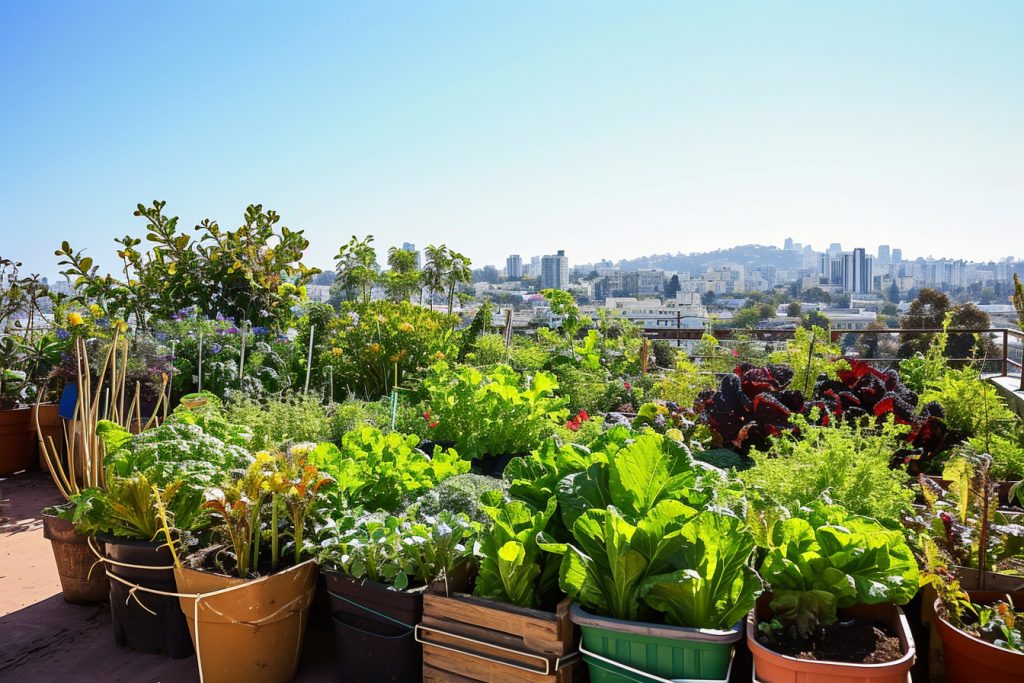Urban areas are frequently criticized for their lack of green space and disconnect from nature. However, a growing movement is turning the concrete jungle on its head—or rather, its roof. Urban rooftop gardening is not just an innovative way to combat this issue but also a step towards sustainable living and food security. Imagine plucking fresh tomatoes for your salad just a few feet above your apartment or watching bees pollinate flowers amidst a skyline of skyscrapers. Let’s explore how gardens in the sky are planting the seeds for healthier cities and citizens.
Raising Crops Above the Streets!
Urban rooftop gardening is the modern farmer’s field, sprouting amid bustling cities worldwide. The concept is simple: transform unused roof space into verdant plots that grow everything from herbs to root vegetables. This form of agriculture is not only aesthetically pleasing, adding a touch of green to the grey cityscape, but it also utilizes spaces that were previously barren. By doing so, it turns dead zones into productive land, contributing to local food production. What’s more, these elevated oases can offer a respite for city-dwellers, creating peaceful retreats where the buzz of traffic is replaced by the rustling of leaves.
Furthermore, rooftop gardens have multifaceted benefits. They can reduce a building’s heat intake, thus lowering air conditioning costs and combating urban heat islands. They also manage stormwater runoff, which can decrease the burden on city drainage systems during heavy rains. The biodiversity they introduce is no small perk either; these gardens can become havens for pollinators and local wildlife struggling to find habitat in urban environments. By raising crops above the streets, we’re literally elevating our approach to urban sustainability.
No Backyard? No Problem!
In the past, the lack of a backyard was a death sentence for the green thumbs living in the city. Not anymore. Rooftop gardens have democratized gardening, making it accessible to those who may only have a balcony to boast of at ground level. Apartment buildings, schools, and even corporate offices have jumped on the bandwagon, often transforming their highest point into communal gardens. Residents and employees can cultivate their little patch of heaven, reconnecting with the age-old practice of growing one’s food, albeit with a modern twist.
The advantages are extensive and personal. Urban rooftop gardens can promote community engagement as neighbors work side by side, nurturing their plants. They can be educational spaces where children and adults learn about the importance of local food systems and the basics of horticulture. Furthermore, the act of gardening itself can have therapeutic qualities, offering a much-needed escape for mental well-being. The message is clear: no backyard, no problem—just look up and get growing!
Urban Jungle: From Concrete to Cucumbers!
The transformation from a concrete expanse to a thriving rooftop garden is nothing short of magical. Once barren rooftops are now bursting with life, growing everything from cucumbers to strawberries. This shift is not just about aesthetics; it’s a tangible change in the ecosystem of a city. The conversion of underutilized rooftops into productive land has led to an increase in urban green spaces, which play a vital role in environmental conservation and climate resilience.
What’s more, these gardens are championing the farm-to-fork movement. Restaurants have started to invest in rooftop gardens to supply their kitchens with the freshest ingredients possible. Imagine savoring a dish in a restaurant while knowing that the vegetables on your plate were grown just a flight of steps above you. This ultra-local approach to food is revolutionizing the way urban dwellers think about and consume their meals. It’s a full-circle moment where the urban jungle doesn’t just connect us to nature; it brings nature to our forks.
The potential of urban rooftop gardening is limitless. It’s a powerful symbol of innovation, blending nature with urban living in a sustainable and community-oriented way. As cities continue to grow, and as the conversation around food security becomes more urgent, these sky-high harvests offer a vision of the future that is rooted in optimism and greenery. By turning our gaze upward, we can transform our rooftops into fertile grounds that feed bodies, minds, and souls. So the next time you’re in a city, remember to occasionally look up—who knows what garden delights might be growing just above you!









